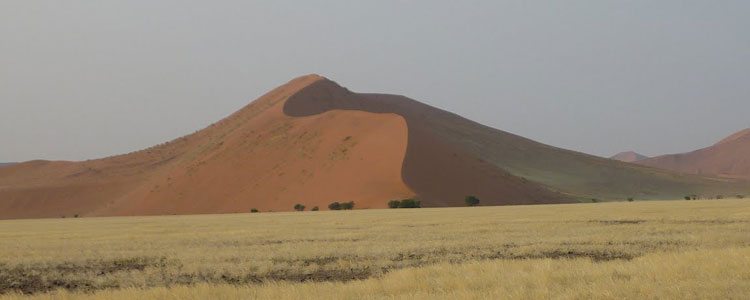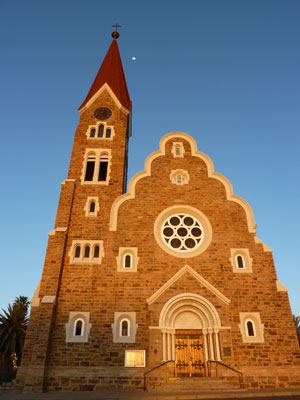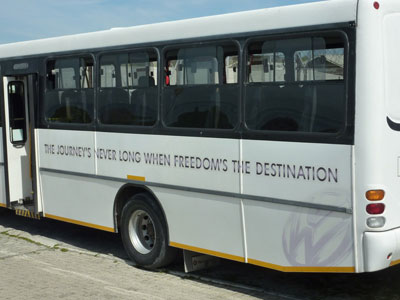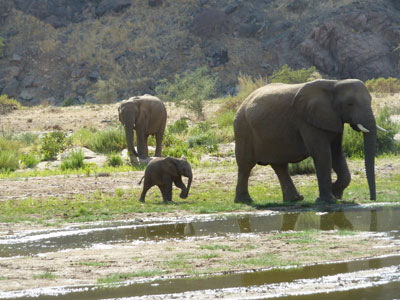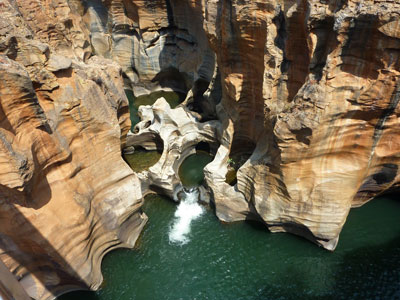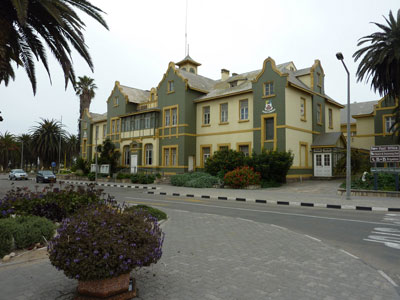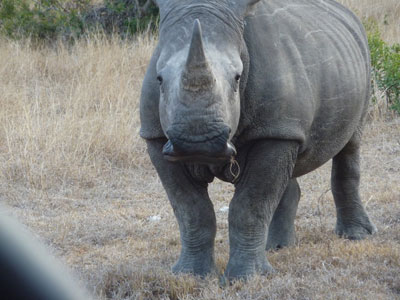South Africa & Namibia—Serendipity steps in and a perfect trip begins
by Judith Anshin, First of two parts
For more than 10 years I had wanted to take a long trip to Southern Africa, visiting South Africa, Namibia, Botswana and Zambia. I decided 2011 would be the year I would do it, no matter what.
I signed up for a tour that included all of those countries, but it was canceled, except for the Namibia portion, due to lack of travelers.
I immediately contacted one of ITN’s advertisers, Africa 2000 Tours (Knysna, South Africa; phone +27 44 384 1262), owned by husband and wife Gill and Graham Maskell. It was truly my lucky day when I decided to ask them to set me up with a tour of South Africa, Botswana and Zambia, as I found them to be the epitome of professionalism and integrity in the caring they showed for their guests.
I allowed six weeks to see the four countries, traveling Sept. 12-Oct. 23, 2011. It was the most perfect trip I ever could have imagined!
Cape Town
I met Gill and Graham in Cape Town, where we all stayed at the Goose Green Lodge, a wonderfully comfortable, family-owned lodge in the suburbs of Cape Town.
Breakfast every morning was bountiful, with juice, yogurt, cereal, bread, cheese, warm muffins and eggs to order. Owners Alan and Linda were great hosts, and Alan and I had some wonderful discussions on world affairs and US politics, as he was formerly in the UK diplomatic service.
On my last night, they invited me to have dinner with their family, and it was a perfect end to a wonderful stay. I felt I had been with family rather than in a B&B.
Cape Town has no end of sights, and my five days there went too fast. Gill and Graham are both government-licensed guides, so they showed me every highlight, including Table Mountain, Robben Island, the little penguins at Boulders Beach, Kirstenbosch Botanical Garden and more.
While the setting of Cape Town is breathtakingly beautiful, the weather can be tricky, so we adjusted our plans according to the weather. I had four days of warm, glorious sunshine and one colder day with rain, which meant a drive in the countryside through the wine country.
The day we went to Table Mountain it was warm and sunny, with great visibility. There were no tour buses or lines for the cable car, and the ascent went too fast to drink it all in. The cable car’s floor rotates as the car moves, so the view was always changing.
Up at the top, there were lots of people, but it was not so crowded that we couldn’t explore every area we wanted. On a beautiful day, one can easily spend the better part of a day up there.
Robben Island
Seeing Robben Island in the distance made me even more excited about visiting it the next day, and it did not disappoint. The ferry ride over was quite pleasant, with beautiful views of the city and Table Mountain.
The guides on Robben Island, all former inmates, are assigned randomly, so we were extremely lucky to be assigned to the bus guided by Yasim Mohammed. Mr. Mohammed, who has guided VIPs such as Hillary Clinton, has an engaging personality and is an excellent storyteller. He wove into his stories connections to the home countries of the tour members and made the past come alive in a special way as we drove around various parts of the island.
One place we stopped to view from the bus was the small hut built to house the first prisoner in solitary confinement, Robert Sobukwe, the founder of the Pan Africanist Congress, who spent six years in solitary. Another stop was the limestone quarry, where the blinding sun on the white limestone caused permanent vision problems for Nelson Mandela and others, who were forced to work long days in the quarry without sunglasses.
Leaving the bus, we walked onto the prison grounds and visited the yard and garden area outside the wing that housed Mr. Mandela for the first 18 years of his 27 years as a political prisoner. His 6-by-8-foot cell had a high window, a thin blanket and a bucket for a toilet.
It was an important stop for everyone on the tour. Despite the beautiful weather, I felt a chill viewing the cell and listening to the guide describe daily life for the prisoners.
Moving on
Eating in Cape Town was a treat. One dinner, at Bhandaris, an Indian restaurant that is a favorite of the Maskells and the Goose Green Lodge owners, resulted in the best Indian food I have ever had (including meals during my five visits to India).
Another night, we visited The Africa Café (108 Shortmarket St.), which had a set menu of 14 dishes from all over Africa — with refills of the dishes encouraged! The interior was very eclectic, and the staff came through to sing and dance during our meal. All of the dishes were quite tasty, and none included any “strange” things such as insects. I highly recommend this restaurant.
Reluctantly leaving Cape Town, I flew to and was met at Nelspruit, then driven to Notten’s Bush Camp in the Sabi Sand Reserve, a private game reserve adjacent to Kruger National Park. Family run, it is one of the original game lodges in the area and houses a maximum of 16 guests.
A distinguishing feature of the place is that the cottages do not have electrical service. I had several oil lamps and many candles in my room and en suite bath, and the ambiance was just magical. Dining by candlelight and having cocktails around the fire pit or dinner under the stars was so peaceful and relaxing. Electrical outlets are available in the bar area to charge camera batteries, iPods and laptops.
My chalet had a large covered porch with a nice settee, so each morning after brunch I would stretch out to read or listen to my iPod and, of course, doze off a bit. Once, I was awakened by the sound of animals eating nearby, and as I looked around I was startled by the small wooden zebra which decorated my porch! Luckily, the warthogs munching on the grass were uninterested in me.
Animal encounters
I was told that game drives in Sabi Sand are better than those in Kruger because off-roading is allowed, as are night drives. With no fences between Kruger and the private reserve, the animals move back and forth frequently, but many have their territory in Sabi Sand.
My first game drive, in the late afternoon of my arrival, resulted in seeing four of the Big Five: elephants, rhinos, a leopard and lions. Sabi Sand has its “own” lion pride, six females and nine cubs, along with two males, all of whom spend a lot of their time in the reserve.
We were told that one of the males killed a 10th cub, so the females attacked him, inflicting serious damage to his right hind leg. We saw him several times resting and licking his wounds.
One morning we saw all the females and cubs resting in a high, rocky area and spent quite a while enthralled by the antics of the cubs.
When an animal is born in Sabi Sand, the lodges slowly acclimatize it to game vehicles, starting with only one vehicle at a time, adding a second vehicle, then a third over time. Only three vehicles are allowed to view an animal or group of animals at any one time, with rangers radioing when one is leaving so another vehicle can come in.
One morning we spent some time tracking a solitary leopard, eventually finding him in a dry riverbed. With four-wheel-drive Land Rovers, we drove down a very steep, scary embankment to reach him, but it was worth the scare. He simply lazed in the shade, totally unconcerned with the vehicles.
Passengers are told not to stand up or wave arms or do anything that breaks the shape of the vehicle, with which the animals are familiar. That way, a vehicle can get heart-poundingly close — a great experience!
Guests have the same game warden/driver and tracker for the twice-daily game drives, and my game warden, Chase, was very professional and funny. He clearly loves his work and the animals, and he provided so many wonderful experiences for us. A highlight for me, personally, was holding a nonstinging scorpion that Chase found one afternoon.
Natural wonders
After three fabulous nights at Notten’s, it was time to leave the great service, superb food and outstanding game drives. I went out on the early-morning drive, then was picked up by another ranger at our coffee-break stop and returned to the lodge for breakfast before my guide arrived for the next leg of my adventure.
Tina Böhm, a national tour guide headquartered in the Hazyview area, was my private guide for the next three days. She was very knowledgeable, outgoing and friendly, so I again felt as if I were traveling with a friend.
I stayed at Chestnut Country Lodge, near Hazyview, and it was another gem, with the best dinners in Africa. Originally a farm, its buildings have been converted into beautiful guest rooms with wonderful views of the countryside. My room was extremely large, with a nice sitting area and a spacious bath.
My tours in this area included a visit to an elephant sanctuary, where I got closer to an elephant than I ever could have imagined. I even touched his tongue! I also was “kissed” on the neck by his trunk.
What I learned there about the anatomy of elephants as well as their behaviors made future elephant viewings so much more interesting.
The next day we drove the Panorama Route, but, because of foggy weather in one section, we were unable to see anything from God’s Window. The other stops along the route, however, were in beautiful weather and were extremely enjoyable.
The route’s geological features, including the Three Rondavels on Blyde River Canyon and Bourke’s Luck Potholes, are quite photogenic, and, on a beautiful day such as we had, a delight to explore. After the dryness and rather flatness of the bush at Sabi Sand, they represented, within a relatively short distance, the opposite end of the nature spectrum.
Johannesburg
Johannesburg was my last stop in South Africa, and my two days there passed quite quickly. I had a private guide on the first day but was joined by another couple on the second.
Our first stop was the first law office of Nelson Mandela. The interior is not open to visitors, but the displays in its large windows were detailed and very interesting. As a retired attorney, I felt pride and a kind of fellowship with him after reading all the displays.
At the Apartheid Museum we had two hours to explore, the minimum needed. Each admission includes a randomly assigned ticket marked “white” or “colored,” and the holder has to enter the museum through the appropriate door. My card read “colored,” and, even though I am white, I experienced a funny feeling walking through that door.
The museum is extremely well arranged, with detailed exhibits. Coupled with my visit to Robben Island, this visit had a profound effect on me.
Although I worked in the civil rights movement in the US, I did not have an understanding of the effects of discrimination on the gut level until the 1980s, when I lived in China for two years, where I was discriminated against because of the color of my skin. All of those feelings came flooding back as I viewed the horrors of the photographs in the museum.
A tour of Soweto in the afternoon was a real surprise, as it is much, much larger than I had expected. Nearly two million people live in the area, covering every economic level from squatters to the wealthy and famous, such as Winnie Mandela and Archbishop Tutu, who maintain homes there.
A visit to the Hector Pieterson Museum was enlightening. Hector was a schoolboy of 13 when he participated in the June 16, 1976, protest march against the implementation of Afrikaans in school. It was planned to be a peaceful protest with a march to a stadium for a rally, but the marchers were confronted by police. When the police started shooting, Hector was among the first to be shot and killed.
The museum has many TV monitors to show footage of the time, but many were not working at the time of my visit.
Next up, Namibia
My visit to Namibia was wonderful, but it was very different from my South Africa experience in that I was part of a small group (four travelers with a guide/driver) and my accommodations, while very good, weren’t at the luxury level I had enjoyed in South Africa.
This 12-day portion of my trip was a previously scheduled tour from Adventures Abroad (Blaine, WA; 800/665-3998), for which I paid full price ($3,640 per person, double occupancy) plus a single supplement of $720.
We four Americans blended very well together, and the tour was extremely enjoyable. I had wanted to see Namibia’s famous sand dunes for many years, and they were as spectacular as I had expected. I hiked only a couple of the smaller dunes, passing on the “Big Daddy” and “Big Mama” dunes because of the heat.
A morning spent on a catamaran in the Atlantic brought us pelicans, whales, two species of dolphins and seals we could pet. “Junior” is a wild seal that got entangled in a fishing net and was rescued by the captain of the boat. Over time, the seal came closer and closer to the boat, and now he jumps onto the boat and allows passengers to pet him!
He knows fish are kept in a small locker on board, so he kept trying to get the lid up to get more while the captain, who used the fish to get him to stretch up, was telling his story. It really was an amazing experience. “Ollie,” another seal who observed Junior getting all these fish, now jumps on board also.
The desert elephants farther north, in Damaraland, were a real treat. These elephants have adapted to living in the desert and are slightly smaller than other elephants.
Niko, our guide, was really outstanding, especially at finding animals. We discovered one herd along a dry riverbed because he spotted fresh dung alongside the road and asked the locals how long it had been since the elephants passed. Finding out they were only 10 minutes ahead of us, we agreed to try to find them, even though it meant putting off lunch. Watching them meander along with local cows, eating along the way, was worth the delay.
The next morning, Niko figured out which way they might have headed and, again, we found them. This time the entire herd was together. There were several males and many females plus a few juveniles and babies. Two of the juveniles spent some time play-attacking, eventually getting tired and lying against the embankment, where they continued “attacking” with their trunks. The two hours we spent watching them went by in a flash.
Winding down
Etosha National Park is enormous. We spent one night at the western end of it, taking a game drive through it, then spent two nights at the eastern end. Our luxurious hotel at the eastern end also provided two game drives each day. All in all, we saw many animals and birds we hadn’t seen before, some quite close up, even though off-road driving isn’t allowed there.
Back in Windhoek, Namibia’s capital, we had a pre-dinner tour of the city. With the jacaranda trees in full bloom, it was a photographer’s dream.
Our farewell dinner took place under the stars at a wonderful restaurant. It was the perfect ending to a great tour.
I was off the next morning for 16 more days of safari in Botswana and Zambia, so this was not an ending.
Next month, the journey continues.
Judith Anshin was given an almost 60% discount by the lodges, guides and Africa 2000 Tours on her stay in South Africa. A similar itinerary would be priced at around $5,676 per person, though Africa 2000 Tours makes every effort to obtain the best pricing possible, depending on the budget given and the number of people traveling.

